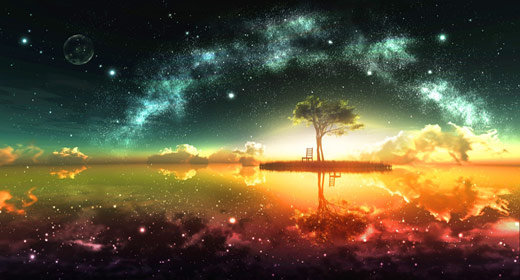Donna Quesada:: We have a new section on awaken that is specially designed for guided meditations.
As we go into our second hour together, I wonder if you wouldn’t participate in guiding me, and by extension our viewers, through a meditation… Would you be willing to do that?
Ken Wilbur: Sure. Yeah, we can start.
Donna: Or do you need a break?
Ken: No. So go ahead and close your eyes. And simply look within and notice that you have two selves. There is the self that’s doing the looking. And then there’s the self that you’re aware of that’s being looked at. And so, as you notice those two sides of your awareness there’s the looker, the subjective side, or the witness in you that’s just aware of everything that’s arising right now. That is your witness. And that witness is held by every mystical tradition the world over, to be God, to be one with absolute reality. And that is your real self.
So just rest as that witness. And don’t worry about the things that are being witnessed, just notice that they’re all objects. And so, your small self, the self that you can be aware of as an object… That’s your ego. That’s your small self. But the witness of that small self, your big self, is Godhead, is Brahman, is big mind, is ultimate reality. And that is the self that you want to identify with, because that is your real self.
So as you rest as this witness, simply identify with that witness and realize that it is seeing everything that is to be seen, and it’s seeing it as an object, because that witness is a pure subject. It’s often called absolute subjectivity. ‘
It just means the ultimate witness. That is what you really are. That’s your real self. And the witness sees everything, but cannot itself be felt. It sees everything that cannot itself really be seen. It’s the seer. And this is why the mystical traditions maintain that nobody can actually see God, because God is the ultimate seer. God is this witness in you, which is witnessing everything, but cannot itself be seen or felt. It’s just… you can be subjectively aware of it, because you’re aware of this witness.
And so, rest as that awareness, rest as that witness, and just realize that as your true self. And let the little self that you’re aware of, just let that go. That’s not who you really are. That’s your mistaken identity. That’s the self that’s caught in samsara, that’s caught in maya, that’s caught in illusion. Because it’s an illusion, because it thinks it can see things, whereas it can’t. It can only be seen. It’s just an object self. It’s not the true subject self. It’s not the real witness. So let the little object self go and rest as that absolute subject, that absolute subjectivity, that pure witnessing awareness. And that is who and what you really are. So that’s a bit of a guided tour.
Donna: I love it. So the small self… is that the ego? When you talk about the small self, would that be the ego self?
Ken: Right.
Donna: And so, is the idea to sort of say, “okay, ego,” like a child, “you get to ride in the backseat”… it’s not about killing the ego. It’s about having it in its rightful place?
Ken: And the mystical traditions usually add a lot of stuff about what the small self goes through. So it feels fear, it feels anxiety, because it really is a mistaken identity. It’s not your true self. It’s not your real self. But it thinks it’s real. And so it’s open to illusion. Fundamentally, its core is an illusion. It thinks that it really sees the world and it knows everything. But it’s actually the witness looking through the ego that gets confused with the ego. And then the ego thinks that it’s doing all the witnessing, that it’s the source of awareness, and it’s not. It is incapable of awareness. It’s just an object. It can be seen. It can’t see anything. It’s just an objective self. And that just means something that can be seen by the true subject, the true self, the witness.
Donna: Is that why the ego, when it’s in charge, it tends to run amok… because it’s caught up in that illusion?
Ken: Right. So that’s why the ego in Buddhism is the source of dukkha, suffering. Because it’s a deeply mistaken self. And of course, the real self is Anatta. A means without. And natta means atman or self. So without self means without ego, without the small self. And that’s what you let go of when you awaken. You’re no longer identified with that small self. In Buddhism, you have become egoless. You are anatta. And anatta is the nature of reality. It’s the nature of nirvana. Nirvana is anatman, without ego self. And that’s when you just let go of the ego entirely by resting in the pure witness. Because you always have access to pure witnessing awareness. It’s what’s seeing everything. It’s what’s hearing everything. It’s what’s touching everything. It’s what’s smelling everything. It’s what’s tasting everything. Just that pure witnessing awareness. And when you just sort of rest as that witnessing awareness, you can sort of start to feel your body dis-identifying with your body, dis-identifying with your mind, dis-identifying with anything you can see.
Donna: There’s a relaxation that takes over. There’s a relaxation that takes over the body. It’s amazing because you let go of everything you thought was against you. There’s no more enemy.
Ken: And all that’s there is the pure witnessing awareness. And that awareness is infinite. It’s one with God. It’s one with Brahman. It is the mind of the universe. And that’s your big mind. Your big mind is as big as the universe. Because it is one with the entire universe. And it’s just witnessing everything as object. So you let go of your body, you let go of your feet, your hands, your intestines, your face, your head, your brain. All of it just drops off.
Donna: So we adopt a kind of cosmic consciousness… We become God, even though that freaks people out to speak in those terms
Ken: Yeah. And that’s where the term “cosmic consciousness” comes from. It’s one with the cosmos. And that’s your big mind. Suzuki Roshi’s big mind. That’s your real mind, his big mind
Donna: I would be remiss if I didn’t ask you about spiral dynamics.
Ken: Sure.
Donna: How does this sort of double up with what we’ve been talking about, this process of waking up and growing up? How does spiral dynamics go hand in hand with this process?
Ken: Yeah. Spiral dynamics is one of the 100 models that I include in the charts in the back of integral psychology. And it was simply a developmental model that was created by a man named Clare Graves, who was really a bit of a genius, a developmental genius. But he simply discovered sort of eight or nine stages of growing up that many other people had already discovered. But he, of course, was looking at a particular multiple intelligence, like Jane Loevinger was looking at ego development, and Kohlberg was looking at moral development, and Piaget was looking at cognitive development.
Clare Graves was looking at values development. And so he actually called the stages B for value Memee, M-E-M-E-E for Memee. So there were nine stages of value means or nine stages of growing up. And they were the same identical stages as all these other models had. But a guy named Don Beck, who worked with Claire Graves towards the end of his life and sort of took care of him in his last years, he simply took Grave’s model and treated it as the single correct model of development, whereas it’s one of a hundred correct models of development. But I like that model, and I used its terms frequently because I liked the way that they used colors to represent them. And I liked the fact that the stages of value did tend to make a lot of sense. And so they were one of the easier stage models to understand. And so I often use those.
Donna: Would you be willing to go through them for us in a brief way, or it’s too complex? Would you be willing to go through those in a kind of thumbnail sketch type way?
Ken: Well, there are all variations on archaic to magic to mythic, to concrete operational thinking to rational theoretical thinking, to pluralistic thinking.
Donna: So it’s still just that process of coming to the cosmic consciousness?
Ken: Well, no. What happens is that the stages of growing up are not the stages of waking up. But what some people, including myself, have proposed is that since growing up stages are made out of this sort of grammar, like rules of development, they even continue to add perspectives like Loevinger has the first person, the second person, the third person, fourth person, fifth person, sixth person, seventh person. There’s no reason you can’t have an eighth person and a ninth person and even a tenth person perspective, because you’re just adding an extra first person perspective on top of the ones you already have.
Donna: I see.
Ken: So at some point, the sort of tenth person perspective starts to look very much like a waking up experience stage. And I have myself suggested that the eighth, ninth and tenth person stages of growing up, although nobody has done this yet except me… and talked about those becoming permanent waking up stages that are integrated with the growing up stages in their eighth, ninth, and tenth person perspective.
So, we don’t have any experimental data on that as of this moment. We just have my theoretical guesses that that’s what will happen. So Don Beck didn’t include those higher stages. He had his ninth stage, which was the integrated stage, and that was as high as he went—my so-called eighth or integral stage of development. And I have four higher stages that I call third tier. And that’s the three highest stages… ones that become fused with waking up stages. So, I don’t know that there’s much to say beyond that, except for those highest three stages, which are simply theoretical stages now.
Waking up and growing up are completely different in their stages and the way they’re created. And the only reason that the three waking up stages become packed on to the highest three growing up stages is that the waking up stages emerge as they normally would.
First stage of waking up appears, but when it appears, it’s immediately fused with that higher growing up stage. So, they actually become integrated automatically. And then when the second waking up stage, which is very different from a growing up stage… but when it emerges as part of the ninth stage, it becomes integrated with that ninth stage. So there’s still two different stages, but they’re integrated. Same with the tenth stage when waking up stage becomes one with it. I call it a “clear light stage.” And I call it that intentionally because in the Tibetan scheme, there is a very high clear light stage, which is sort of one of their highest stages. And so, that stage could be high enough to be integrated with a growing up stage. And that’s why I call it the “clear light stage.”
Donna: Well, it is interesting the way these different thinkers from different areas of study, from psychology to even different spiritual traditions, have various models that mirror these stages in different ways. I don’t know if this is way off or not, but even the chakra system in yogic science seems to take us through this process of waking up in stages, moving from a more primitive worldview to a more cosmic consciousness.
Ken: And what system is this?
Donna: The chakras in yoga, where you move through these different color coded levels of awakening to the point where you get into the Sahasrara, this cosmic awareness of oneness.
Ken: That’s true. And interestingly, the lowest three chakras do match their characteristics with the earliest three stages of growing up. Their structures are entirely different. I mean, the chakras are energetic systems with certain forces and powers and energies. And the growing up stages aren’t anything like that. They’re rules of grammar. They’re not systems of energy or power. But they do produce similar types of effects. So the first chakra is the purely physical, material domain. The second chakra is the emotional, sexual domain. The third chakra is the power chakra, the egocentric power chakra. And then the fourth stage actually gets into the beginning of conformist and conventional love stages. ‘
Donna: The heart, yeah.
Ken: So there is those sort of strange coincidences, but they’re still very different in how they function and what they’re made of. And they don’t evolve at the same time together at all. Except maybe the first and second, simply because they are the earliest stages that appear in the first to third years of life. So, simply because it’s a time overlap, they can emerge at similar times.
Read and Watch Pt 1 Here: Awaken Interviews Ken Wilber P 1 – Every Sentient Being Including a Dog, Has a Buddha Nature
Read and Watch Part 2 Here: Awaken Interviews Ken Wilber Pt 2 – Not I, but Christ liveth In Me
Read and Watch Pt 3 Here: Awaken Interviews Ken Wilber Pt 3 – Waking Up Is Just Not Enough, We Have to Grow Up
Read and Watch Part 5 Here: Awaken Interviews Ken Wilber Pt 5 – Finding Radical Wholeness
Read and Watch Part 6 Here: Awaken Interviews Ken Wilber Pt 6 -You Can Lose Your Fear In Fifteen Minutes










































